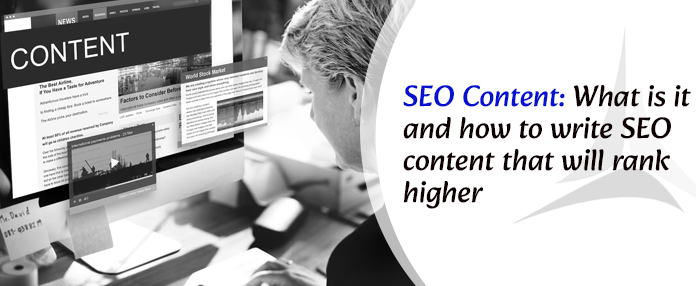
SEO Content Optimization: What is it and how to write SEO content that will rank higher
SEO (Search Engine Optimization) for any business website requires solid content that implements SEO factors such as keywords, meta titles, and more. SEO content refers to well-organized, well-defined content optimized for search engines. The content on your website is engaging and mapped out for your audience to provide them with informative solutions they are looking for on web searches.
When web users visit search engines, they are primarily looking for information. So, to reach your target audience, your content should be enhanced and written for two audiences- Your target audience and search engine crawlers. Content optimized with keywords will assist search engine crawlers in ranking your content higher.
SEO content is written for the target audiences and search engines using keywords. So, search engines can recognize these keywords and rank your content to your target audience. However, how can you ensure your content is SEO optimized, and how can you write the best SEO content? Let’s find out:
SEO Content Strategy
First, you need to develop your strategy and interpret what you expect from your content. Content strategy refers to keyword research and optimized solutions to write informative and engaging content for audiences and search engines. To write interesting content, here are a few things you need:
• Research your keywords to integrate them into your content to reach your audience.
• Using keywords intelligently across the range.
• Develop engaging and informative content.
• Market or promote content on various marketing channels.
• Use visualization factors like images, videos, and flowcharts for better understanding.
Ways to develop SEO content strategy
Optimization of website content is a critical element of search engine optimization. Increasing your website’s search engine ranking can lead to improvement. Its visibility and credibility. Help you reach your audience. To develop SEO content, businesses or SEO experts need to develop strategies. Here are some ways to develop these strategies:
Set your goals: Why do you want to make your content SEO optimized? What do you want to achieve via SEO content? Is it lead generation, more target audience, or provide information to your customers? Set your goals for SEO content.
Your target audience: Who are the readers of your SEO content? Identifying your target audience is crucial. Understand their expectations of your brand.? Know your target audience to develop content accordingly.
Keyword research: It is essential to conduct keyword research. Developing successful content. SEO content. To ensure you reach the specific audience wherever they search the web. So, make sure you research keywords intelligently.
Plan your content: When you know your audience, what they expect or require, and keywords, it’s time to plan your content. Decide the type of content you want to write and develop a well-organized content calendar to ensure you regularly develop your content.
High-quality content: Maintain and optimize your content quality. Your content should be accessible for the audience to understand and quality enough for your brand reputation and search engines. In addition, provide a balance of informative and engaging content.
Upgrade existing content: Regularly optimizing websites., it’s essential to organize and upgrade existing content. Update any new information on the topic or add new keywords, etc.
Implement SEO techniques: SEO techniques, including on-page SEO, should be implemented on content to improve website SEO. It includes meta titles, descriptions, and keywords.
Tracking: Monitor and analyze your content, keywords, and how it’s performing. It will help you identify improvement areas. So, it will help improve your mistakes and amplify SEO for high rankings.
Categories of SEO Content
Website content can be categorized in various ways; what you write or choose will depend on your target audience. Your website visitors or target audience should be able to understand and relate to your content. So, you can long for them on websites for a long time, giving you a chance to generate leads. You can write different content categories depending on your business niche, SEO goals, target audience, and other factors in content strategy. So, check out the following most common SEO content types:
Blogs and Articles( Long Content): This refers to content that is longer than usual, typically consisting of 1500 words or more. This type of content provides detailed information about the topic to users. It allows experts to use short-tail and long-tail keywords effectively to target the target audience. Moreover, Google crawlers can understand the quality and rank your content higher effectively.
Product or Service landing pages: These pages are created to guide potential customers to the service or product page of your choice, generating leads in the process. The landing page content is sales oriented and optimizes SEO when product information and keywords are implemented.
Website Content: Complete brand website of any business include various pages such as a home page, services or product page, blog or resource page, contact page, and more. All these pages need SEO optimized with content that appeals to the audience, includes keywords, and have high technicalities such as compressed images, structure, etc. This page is the face of business, where content will describe your audience and search engines about your brand.
Infographics: Many people like reading content to get information; however, almost everyone will want to read content they can easily comprehend. Infographics help users to understand the content or written information better.
Case Studies: These testimonials will help your website visitors know how your products and services helped your customers. Ensure you have chosen case studies your target audience will most likely search for.
Videos: Videos are important in a digital world where everything and anything goes viral. So, updating your website with quality video content is important and helpful. You can optimize website videos by including meta titles and meta-alt descriptions.
Tutorials and Guides: Many web users visit search engines to gain information. They need to know about different things that tutorials or guides can offer. So, having a separate blog or resource section can help you target such an audience to drive your website. Create quality guides or tutorials about different topics in your business niche. You can add value to your SEO if you answer what the audience wants.
White Papers and ebooks: Whitepapers is a detailed content reports on topics where an issue is presented along with a solution. Such content includes long information where the problem, methodology, and solution are structured. These types of content can be authoritative and allow strong SEO implementation. E-books for your website can be downloadable content for your users to provide information and contribute to SEO.
Local content: Local content in SEO is content targeted to local web searches. Text, images, and videos are optimized per local web searches, such as if your target audience is looking for local bookstores or restaurants to explore. At the same time, you have a blog on top restaurants in the area. So, such content should be optimized as per the local SEO audience.
FAQs/Q&A: Many people do not understand or have queries about your products, services, or brand. FAQs or Q&A content help in such cases; you can resolve your customers’ general queries, and it will positively impact search engines.
User-generated: UGC- User-generated content created by users who use your website, products, or services. The content can be in the form of pictures, videos, or reviews of your services. Such content is highly influential for your website visitors and their purchase decision. You can add reviews and testimonials to enhance your sales and SEO.
Steps or ways to write SEO content effectively
To effectively write SEO content that your target audience will accept and search engines promote, there are a few things you need to follow. Content optimization before you start writing can be the best way to ensure a high level of SEO Integration. Your content should start with developing a strategy and continue with writing. Here’s how you can write SEO content for your website:
Keyword Research
When you have planned your content strategy, knowing what type of content you need to write, its audience, and topic, keywords is your next step. Research keywords that are highly researched about your topic and niche. List down all long and short-tail keywords and high and low-volume keywords. It will help you write content integrated with a mix of all keywords and help you write well-optimized keywords.
Develop an outline for the type of content.
After keyword research, create an outline of your content based on the type of content you are writing. For instance, if you are writing an article, the common structure can be an introduction, subheadings, and main body, conclusion. Similarly, there can be other structures that you can customize as per the content you are writing. It helps you stay organized and within the word, limit to create engaging and informative content.
Content draft
Once you have planned an outline, it’s time to research articles from the same topic and niche. Check out their approach if your competitor has written an article on the same topic. It will help you understand what they are missing, what quality you have to exceed, and what you can do to stand out among the target audience. Create a draft as per the structure designed for your website to ensure you write well-organized content.
Identify mistakes and edit
Take feedback from customers, colleagues, or anyone to understand different perspectives on content. Sometimes we fail to identify mistakes. The third person can look for minor mistakes. You can rectify and edit these mistakes to improve the quality of content to ensure you are providing the best for your audience.
Setup SEO elements
When you are done writing content, it’s time to add more features to optimize SEO for your website. These elements include meta title, meta tags, meta description, alt description, hashtags, internal linking, images, infographics if required, and more. SEO experts will add these features to amplify the content for search engine crawlers.
Monitor and analyze
Analyzing how your content is performing is critical. Suppose your content is not up to mark, not able to rank higher, that means your content is not up to mark. You need to identify your target audience’s need and what they are looking carefully to implement in your content strategy. After updating content to monitoring, upgrading regularly to drive results is important.
Way to optimize your website content
Whether you are writing fresh content or upgrading existing content, optimizing for SEO is important to rank your content higher. SEO experts use the following methods or ways to optimize content:
Keyword research: For SEO content, keywords are the foundation. So start your content optimization by identifying the right keywords. Tools like Google keyword planner or Trends can be used for identifying keywords from a business niche. From long tail keyword seo and short-term keywords to high and low-volume content, you can find keywords that will drive traffic. Use these keywords in headings and throughout the content effectively.
Use text to describe non-text content: Content on the website, such as images, infographics, videos, etc., must be described using text. Use meta title, title tag, meta description, and alt text to describe non-text content.
Clear content: Make sure you clear your intent at the beginning of the content. Share a brief idea of what your target audience and readers can expect from your content. Understand what your target audience is looking for and what they want from your brand. Write content that describes your intent in the beginning.
Prefer long form of content: When deciding on the type of content, you prefer a long form of content. It allows you to use SEO keywords throughout the range in a natural and balanced way. In addition, you can include other SEO techniques like link building.
Use external and internal link building: Link your content with other web pages when implementing SEO factors. For external linking, make sure you use quality and authentic websites.
Readability: Writing content is only possible if your target audience understands. So, ensure your content is easy to read, and your audience can understand the information.
Implement markups and descriptions for search engines: Search engine crawlers should be able to understand everything on your website effectively to rank. So, ensure you add alt text, markups, and descriptions for all text and non-text content.
Provide CTA: Provide CTA at the end of the content or wherever applicable to ensure visitors or readers can connect to your website. You can create more customers and generate leads by adding CTA at the right place.
Categorize pages: Categorize similar web pages and related pages into one category. It will allow crawlers to understand and help you organize your website.
Checklist to follow for SEO content
When writing SEO content or optimizing content, there is a checklist that you can follow. Here is the SEO checklist to follow:
Keyword Research: Follow a few things when searching keywords, such as:
• Find the correct set of keywords for the target business niche and audience.
• Use SEO keywords effectively throughout your content.
• Do not stuff keywords; make sure to use them naturally.
Meta Description: If you are writing a meta description for your website, here are things to follow:
• Use the main high-volume keyword in the meta description.
• Keep meta description short, clear, and informative under 160 characters.
Title and header Tags: Tags will attract audiences as well as crawlers. So, follow these tips:
• Use the main target SEO keywords in the title and header tag.
• Keep the title and header tags creative, clear, and concise with a title tag of 70 characters.
• Use H1, H2, and so on for headers.
Content features and specifications: SEO content should have high quality that you can achieve with:
• You are writing informative and engaging content.
• Proofreading content before publishing.
• Long-form content with a minimum of 1500 words can help you with more effective keyword integration. So, aim for long-form content.
• Ensure your sentences are short and paragraphs are limited to 4-5 lines.
• Use active voice more than passive voice.
• Structure content with headings and subheadings.
Internal and external linking: Link building is a strong SEO factor for optimizing websites. So, here is what you need to follow for internal and external linking:
• Add internal links for relevant content to drive traffic on your website between web pages.
• Get quality external links for your website.
• Add anchor text with linking.
URL optimization: Optimize your website URL as follows:
• Short descriptive.
• Use target keywords in URLs.
• Avoid using symbols or any special characters.
Image Optimization: When you are planning to add images to content, optimize using these tips:
• Add alt text for all images.
• Describe the image accurately in brief.
• Add relevant SEO keywords to the title tag and file name.
Mobile-optimized content: Your SEO content should be mobile-friendly to reach an audience; here’s how:
• Develop mobile-friendly content.
• Use mobile-optimized and responsive design.
• Check your content on mobile to get feedback and test.
Social sites: Promoting your content on social media platforms is important. Integrating these platforms with the website can help. Here are tips for implementing:
• Add social media site icons to your content.
• Link your accounts and make sure it’s visible and working.
• Use creative titles to encourage sharing on social media platforms.
FAQs
1. How do I create content for SEO?
You can create SEO content by implementing SEO techniques, and all follow the practical tips mentioned in the guide above.
2. What is SEO content?
Optimized SEO content helps search engines rank your website higher and reach your target audience.
3. How do you write content that ranks?
Follow all significant and minor SEO factors for text and non-text content on the website that engage and attract search engines and target audiences.
4. How do I create content?
Start with finding keywords and a list of trending topics, and write easy-to-understand content integrated with SEO keywords.
5. Why is SEO content important?
SEO content helps websites drive traffic, amplify visibility, and encourage audiences to purchase.
6. How much content is SEO?
It varies or depends on the type of content you are writing. Generally, SEO content can range from 250 words to 2000 words. However, the key factor is quality, so if it’s high-quality content, it can offer positive SEO results.
7. What are the 5 types of content?
Content can be categorized into many types; here are some of the blog, article, user-generated, FAQs, tutorials, and web content.
8. What are the best types of content?
The best types of content are informative yet engaging. Content that can engage customers and provide information for both search engines and target audiences.





